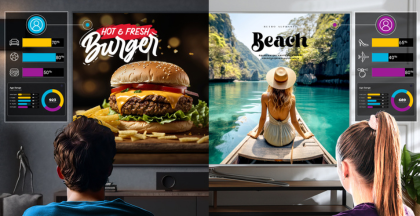In an era where video streaming has gained immense popularity, the landscape of primary distribution is undergoing a major transformation to meet the ever-growing demand.
This blog will delve into the shifting dynamics of video primary distribution and how you can position yourself for success.
What is video primary distribution?
Primary distribution is the process of delivering fully originated linear channels from a content owner to various distribution affiliates or partners, such as pay-TV operators, free-to-air broadcasters, MVPDs, vMVPDs, and OTT platforms.
The legacy video distribution models relied on two main types of network architectures: satellite and IP. However, as video streaming grows, and as business requirements change for content providers, more flexible and agile content distribution methods become a must-have.
The evolution of video primary distribution
Traditionally, satellite was the backbone of primary video distribution. While satellite transmission and reception links demand substantial investment and time-consuming set-ups, IP-based delivery and cloud operations offer a new realm of possibilities. IP-based delivery and cloud operations enable video programmers with unparalleled flexibility.
These technology advancements allow operators to not only reach a wider audience but also drive cost efficiencies while maintaining agility as video delivery requirements evolve. Simultaneously, many operators are transitioning to hybrid distribution frameworks, which merge satellite and IP. These hybrid systems seamlessly integrate streaming services, fostering business growth.
Let’s find out which crucial factors are accelerating the transformation of video primary distribution.
Key drivers for the transformation of primary distribution
Content providers are adopting newer approaches to primary distribution due to several key factors, including:
- Personalized content and advertising: Today's consumers crave content tailored to their preferences. The cloud offers boundless personalization opportunities. This includes delivering personalized sub-channels for individual affiliates and even targeted ads at the individual viewer level.
- Diverse distribution platforms: Content now reaches an ever-expanding array of platforms, from traditional broadcasters to direct-to-consumer streaming platforms. The cloud offers content providers the flexibility needed to cater to these diverse platforms.
- Technological advancements: Technology breakthroughs in video processing and delivery are improving viewer experiences and streamlining operations. Innovations like edge processing are revolutionizing video content handling. By moving video processing closer to the end-user device, operators can minimize latency and optimize video workflows.
- Satellite bandwidth reallocation: The rollout of 5G is reshaping the satellite landscape, leading to a repack of bandwidth. This results in less C-band spectrum available for satellite content delivery.
Preparing for the future of primary distribution
To stay ahead in the evolving landscape of primary distribution, consider the following:
Leverage cloud capabilities: Adopting a cloud-based platform guarantees scalability, flexibility and reliability. A cloud-based platform uses the open internet with point-to-point SRT links or public CDNs for robust video content delivery. This approach slashes costs tied to long-term fixed satellite contracts and accelerates affiliations.
Customized content: Consumer demand for personalized content is growing. A cloud distribution platform enables content providers to create multiple channel variants and personalize content with a dedicated manifest file for each affiliate. These tailored channels can bolster ad space and revenue through dynamic ad insertion (DAI).
Harness edge devices with central remote control: Equip affiliates with powerful edge devices controlled from a central point to quickly adapt in real-time. With edge technology, affiliates can add & remove channels, schedule blackouts, insert graphics, and monitor the devices.
Hybrid distribution: A hybrid distribution solution supports both satellite and the cloud. Combining the reliability of the satellite with the elasticity of the cloud offers the best of both worlds to the content providers. You can quickly establish links to new affiliates and expand your global reach without the long setup and commitment required for satellite. Having a unified workflow for primary distribution enables affiliates to ingress video in any format and receive content from cloud and satellite streams simultaneously.
Bandwidth optimization: The 5G spectrum repack has reduced a lot the bandwidth available to operators. Regardless of the distribution approach (satellite, cloud, or hybrid system), efficient codecs are essential for content providers to optimize bandwidth.
Ensure service continuity: Content providers need to ensure that their linear streaming channels are delivered reliably. Adopt primary distribution solutions that offer robust deployments and geo-redundancy across multiple cloud zones. Cloud-neutral solutions provide additional resilience by allowing redundancy across different cloud service providers.
Video primary distribution will continue to evolve
The landscape of primary distribution is in flux, driven by a surge in video streaming and technological advancements. The move towards cloud-based and hybrid distribution solutions is the key. These next-gen solutions offer content providers the tools to expand their reach, streamline workflows, and deliver personalized content.
While the shift to a fully cloud-based architecture will be gradual, the benefits are clear: increased flexibility, reduced costs, and the ability to meet ever-evolving consumer demands.
Harmonic is empowering content providers to optimize video primary distribution through its three groundbreaking products. Harmonic's VOS®360 Media SaaS enables service providers to create, monetize & deliver linear TV, and live streaming, from public clouds to affiliates. Harmonic's VOS®360 Ad allows content monetization with massive scalability. Harmonic’s XOS Advanced Media Processor is present at the edge, supporting a large range of interfaces to satellite and cloud (SRT, HSL), descrambling, transcoding, decoding, or passing through content to the affiliates.
Ready to secure your place in the future of primary distribution? Connect with us today.










